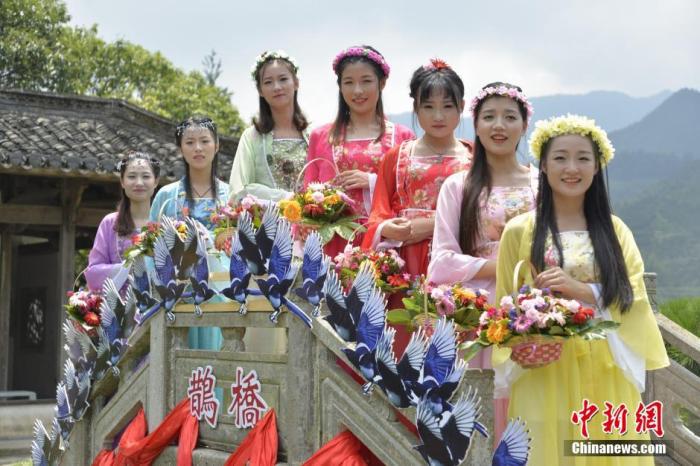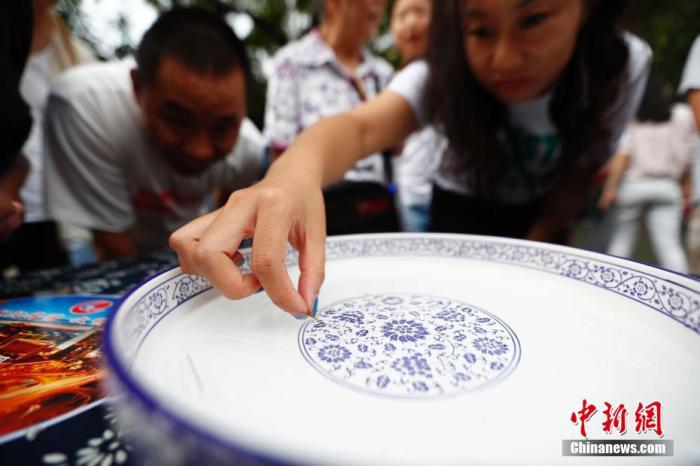Seven Cold Knowledge of Tanabata: Is it Valentine’s Day or a holiday for single women?
Beijing, August 25th (Reporter Shangguan Yun) In recent days, Chinese Valentine’s Day is undoubtedly a hot topic. Young people are happy to have a date festival, and many businesses are also aiming at business opportunities, hoping to make a big profit.
Today, Tanabata is often regarded as "Valentine’s Day in China". Speaking of it, since ancient times, it is indeed a very romantic festival, including the theme of love, and its connotation is far broader than many people know.
Cold knowledge one:Why is Tanabata also called "Daughter’s Day"?
Chinese Valentine’s Day originated in China on the seventh day of the seventh lunar month.

Data Map: As the traditional Chinese Valentine’s Day in China approaches, the theme of Qiuling in Wuyuan, Jiangxi Province is "Begging for Cleverness", and it is intended to hold activities such as "Meeting at the Que Bridge" and "Weaving Girl by the Cowherd’s Creek" to welcome Qixi. Wang Jian photo
There are many names for this festival. In ancient times, the main participants in some of its activities were young girls, and the content of festival activities was mainly begging for skills, so people called this day "Begging for Skills Festival" or "Girls’ Day" and "Daughter’s Day".
Due to the long history of festivals, various customs such as breeding and seeking children have been formed. Many interesting riddles have also been derived. For example, there is a riddle titled "It’s not too late to worship Kuixing on a moonlit night", and its answer is "Chinese Valentine’s Day".
Cold knowledge 2:What does it have to do with the legend of Cowherd and Weaver Girl?
There is a beautiful legend on Tanabata, which is the love story of Cowherd and Weaver Girl. In Searching for the Gods, the Cowherd and the Weaver Girl in the sky are interpreted as the story of the filial son Yong Dong and his wife in the Han Dynasty.
However, this legend happened on the seventh day of the seventh lunar month, and it was also related to the ancient people’s observation of the actions of Vega and Altair, so that the ancients could learn about the arrival of autumn.
According to ancient records, at that time in July evening, Vega just rose to the highest point of the year, which was clearly visible. In addition, the two dark stars next to Vega look like an opening to the east, and when you look to the east, you can see the "Altair".
Therefore, based on all kinds of data, some people think that there will be a legend that cowherd and weaver girl meet on Tanabata, which is also related to the observation of seasons and astronomical scenes.

Data Map: The vegetation on the field of Hengxi Street in Jiangning, Nanjing has been carefully produced by local villagers, and the picture of "Dong Yong meets the Seven Fairy Magpie Bridge" is composed of shrubs, rape and wheat. China News Service reporter Li Bo photo
Cold knowledge 3:Is this a holiday for single women?
Today, Tanabata is known as "China Valentine’s Day". However, there have been views that this was a festival for single women.
According to this view, in ancient China, Chinese Valentine’s Day should be the happiest day for single women: at this time, they can go out to party and play with their sisters in full dress.
Wang Juan, a folklore expert, said that this statement is not very accurate. In ancient times, one of the main contents of Chinese Valentine’s Day was begging for cleverness, which was mostly celebrated by unmarried girls. In some areas, this day is a rite of passage for girls.
Cold knowledge 4:How does the "Qiaoqiao Festival" "Qiaoqiao"?
When it comes to the theme of "begging for cleverness" on Tanabata, the more popular games are asking for cleverness with needles, asking for cleverness with spiders, and so on.
Needle-piercing began in Han dynasty and became particularly popular in later generations. "Miscellaneous Notes on Xijing" said: "Women in the Han Dynasty often wear seven-hole needles in the Kaijin Building on July 7, and people have Xi Zhi."
Another method is "floating needle". Wang Juan introduced that the girls would prepare a basin of water one day in advance and put it in the courtyard, and there would be floating dust on the water the next day. Then, the girls put the needle in and observe the projection of the needle after the sun comes out.

Data map: The picture shows the people’s experience of throwing needles.
Later, "Qiqiao" gradually emphasized women’s participation. In ancient times, girls worshiped the Weaver Girl, which was also "seeking cleverness". Sometimes, skillful girls are selected through some competitive activities.
Cold knowledge 5:Why are you drying books and clothes at this time?
In addition to all kinds of legends, there was also the custom of drying books and clothes at this time.
Liu Yiqing’s Shi Shuo Xin Yu recorded some anecdotes of celebrities from the late Eastern Han Dynasty to the Wei and Jin Dynasties. One of them mentioned a very interesting story: On July 7th, Hao Long, a famous person in the Eastern Jin Dynasty, ran to lie in the sun.
Someone asked him why he did this. Hao Long said "I print books" and secretly poked his knowledge.
It was originally a custom to dry books and clothes on July 7th. During the Wei and Jin Dynasties, some wealthy families in Beiruan also took the opportunity to "show off their wealth", and the clothes that came out of the sun were particularly good in texture and dazzling.
Ruan Xian, one of the "Seven Sages of Bamboo Forest", was also very calm to take a bamboo pole and pick an old dress to dry. Others were particularly curious when they saw it, but he said, "I can’t avoid customs, but I can’t talk to you again."
Cold knowledge 6:The most famous seasonal food "proper fruit"
Just like jiaozi in the winter solstice and the Youth League in the Qingming Festival, there are festive foods on Qixi Festival, the most famous of which is called proper fruit. Proper fruit is mainly made of oil surface molasses, etc. There are many patterns.

Data Map: The picture shows the girls dressed in Hanfu showing the most traditional festival cultural content of Tanabata — — Offering sacrifices to the stars for cleverness. China News Service reporter Liu Kegeng photo
In ancient times, proper fruit had many beautiful names, such as "Laughing and Disliking Children" and "Fruiting and Eating Patterns", while the patterns included "Sixiang" and "Fangsheng". In the Song Dynasty, proper fruit on the Qixi Festival was already available on the market.
Mix sugar syrup with flour and sesame seeds, mix well and spread it on the chopping board to defend it … … After a series of processes such as frying, proper fruit is ready. A clever woman can make proper fruit into various shapes related to the legend of Qixi.
Of course, in different dynasties in history, there were different food customs on Qixi Day, and there was a saying in the Six Codes of the Tang Dynasty that "bread was added on July 7th".
Cold knowledge 7:Can Tanabata say "Happy Festival"?
Generally speaking, Tanabata is far richer in connotation than "love", and it has many contents such as seeking children, begging for cleverness and praying for a bumper harvest.
Tanabata is undoubtedly an auspicious festival, and people will send blessings to couples on this day. Perhaps considering the love theme of the festival, some people make fun of it, which is not suitable for saying "Happy Holidays" to singles.
"On Tanabata, it’s ok to say happy holidays." Wang Juan thinks, but this is indeed a festival for some people, but it goes without saying that it is a festival.